
| What is Flavor and Fortune? |
| How do I subscribe? |
| How do I get past issues? |
| How do I advertise? |
| How do I contact the editor? |
Read 12988317 times
Connect me to:
| Home |
| Articles |
| Book reviews |
| Letters to the Editor |
| Newmans News and Notes |
| Recipes |
| Restaurant reviews |
| Article Index (all years, slow) |
| List of Article Years |
| Article Index (2025) |
| Article Index (last 2 years) |
| Things others say |
| Related Links |
| Log In... |
| Authors |
| Categories & Topics |
Hangzhou Menus and Museums
| by Jacqueline M. Newman |
Chinese Food in China, Hong Kong, and/or Taiwan
Spring Volume: 2009 Issue: 16(1) page(s): 5, 22, 23, and 29
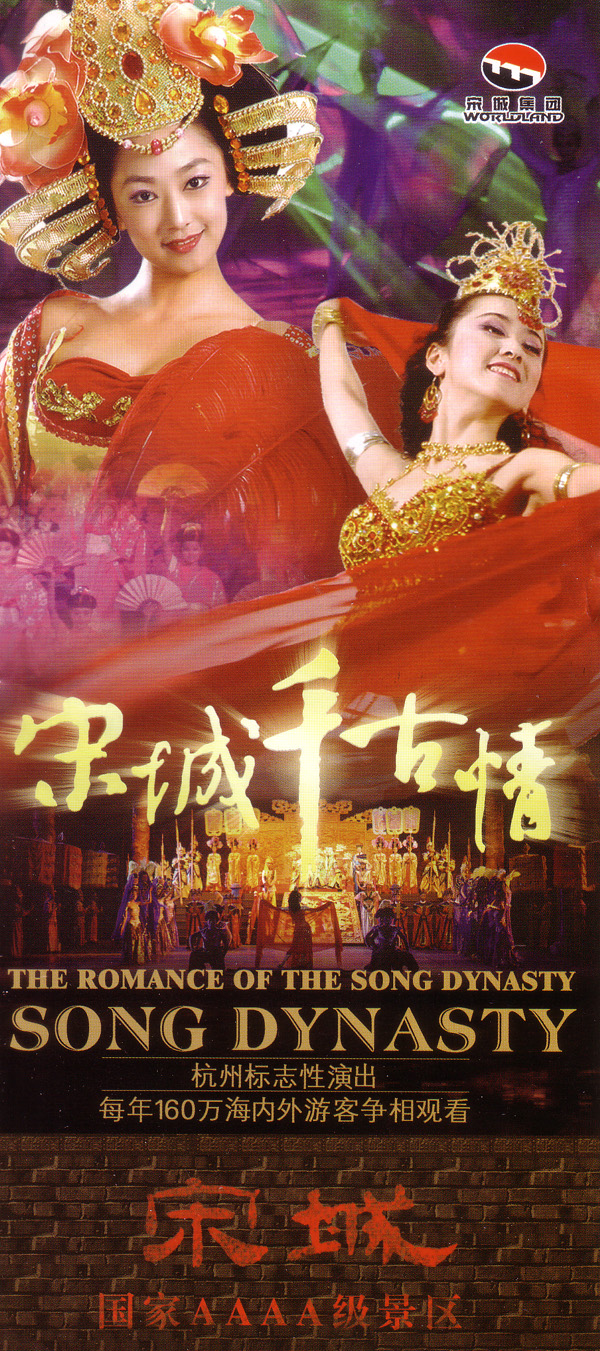 Hangzhou, the capital of the Zhejiang Province, is a popular tourist site for Chinese and non-Chinese alike. Folks come to see the West Lake and other scenic spots, eat wonderful food, visit many national museums, and shop for silk, tea, and other Chinese products. They also come to Paradise Park, a newer extravaganza featuring Song Dynasty life from 960 to 1279 CE.
Hangzhou, the capital of the Zhejiang Province, is a popular tourist site for Chinese and non-Chinese alike. Folks come to see the West Lake and other scenic spots, eat wonderful food, visit many national museums, and shop for silk, tea, and other Chinese products. They also come to Paradise Park, a newer extravaganza featuring Song Dynasty life from 960 to 1279 CE.
Once the capital of the Southern Sung Dynasty, a large portion of Hangzhou was destroyed during what was called the Taiping Rebellion in the mid-nineteenth century. Since being rebuilt, this city has much to offer including its many tea houses, loads of fans for sale, beautiful dishes, and delightfully delicious ones to eat. It should be a must for everyone who visits China. As readers know, we travel stomach first, so this great city pleases and it feeds the brain.
FEASTING IN HANGZHOU was great in the past; it still is today. With many fond memories of great meals here, we expand those thoughts adding new fine experiences recently. This past trip required deciding where to eat and wondering what will be missed. Deciding where to go and what to order begins with many recommendations and only a few days to fit them in.
The city of Hangzhou has great local, provincial, and far away Chinese eateries worth visiting. As the capital of the Zhejiang province, one of China's eight great cuisine regions, it serves ancient and modern specialities. Eating here challenges where to go and a privilege trying them all. Typical questions we consider are: Should we order Beggar's Chicken, a bird wrapped in lotus or other vegetable leaves with an outside coating of mud or clay? It is always a winner here. Or, should we delight and devour their famous Dungpo Pork? This great long-braised beauty is a dish we taste and deem terrific. What about luscious shrimp stir-fried with Longjing tea leaves? Then there is West Lake Fish made in a sweet and sour sauce; what about having that? These legendary Zhejiang provincial dishes have always been great.
Years ago we ate in Louwailou on Solitary Hill in the heart of West Lake. We love this hundred-plus-year-old eatery serving so many terrific dishes. Should we return there and again enjoy their phenomenal food or find a new eatery?
Besides great food, Hangzhou, a hundred fifteen miles south of Shanghai and at the southern terminus of the Grand Canal on the East coast of China and on the West Lake is home to many great museums that feed intellectual needs. Ancient kilns show the history of pottery and soy sauce making, the Zhejiang Museum's hundred thousand general cultural treasures enlighten horizons about this country, and the China Silk Museum feeds needs for understanding this beautiful Chinese-originated fabric.
This province is also where Jiande man was found. That told the world that humanoids lived here fifty thousand years ago. There are a thousand plus neolithic sites to visit including the Kuahugiao ruins where eight thousand years of antiquity are displayed. Hemudu culture was operational five thousand years ago, so visiting of of these sites feeds brain cells. Close by are Ningbo, Quzhou, and Linhai, all with historic importance and great food. Selecting eateries in and near Hangzhou can be a frustration; there is much to taste visually and in reality.
Zhejiang, home to famous and fabulous fruit orchards, duck farms, tea gardens, and more, means foods from a river and the nearby ocean; both provide so many foods to enjoy. They arrive daily at its finest restaurants. Below we share two wonderful food experiences and an equal number of intellectual ones to fill-you-up. All four are spectacular, so do enjoy reading about them, and then one day enjoying them in reality.
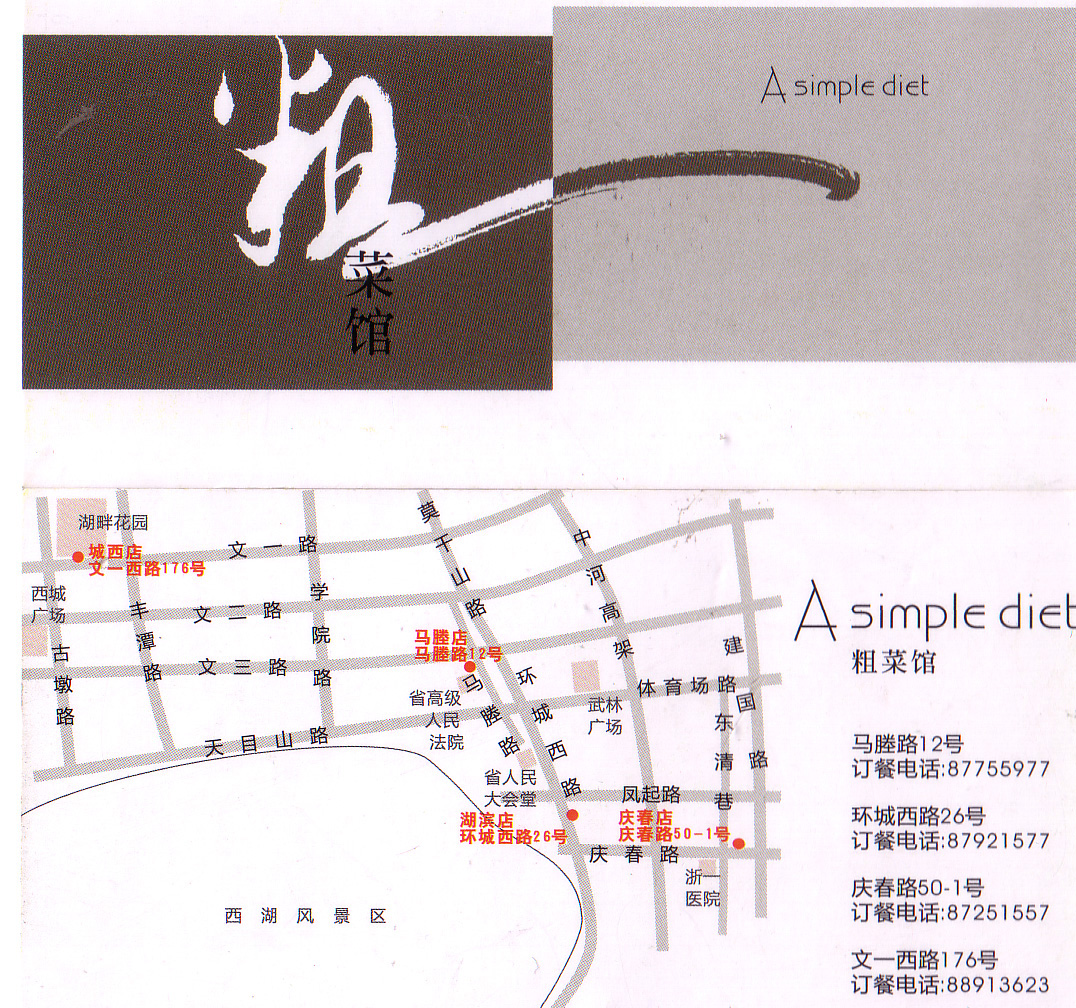 A SIMPLE DIET at 26 Huan Chen West Road in Hangzhou; their phone: (0571) 8792 1577 is a new place we try one evening. Near the Lakeview Hotel on Huanchen Road, it is worth seeking out. We arrive and note the downstairs in shambles. Friends lead us around the back and up two flights of stairs to a floor complete and beautiful. It features foods from a single Zhejiang County we know not.
A SIMPLE DIET at 26 Huan Chen West Road in Hangzhou; their phone: (0571) 8792 1577 is a new place we try one evening. Near the Lakeview Hotel on Huanchen Road, it is worth seeking out. We arrive and note the downstairs in shambles. Friends lead us around the back and up two flights of stairs to a floor complete and beautiful. It features foods from a single Zhejiang County we know not.
Decor here is black, gray and white, its food a fine color contrast. It has many small private eating areas either side of a central hallway. Worth climbing over electric wires, plumbing parts, and boxes of who knows what we are rewarded, after we order, with wonderful modern and historic dishes.
Only one hard-bound menu exists. It needs sharing to enjoy pictures and words about their Dong Yang County cuisine. We pass it back and forth and need time to discuss and decide. The waitress, in a gray multi-pin-tucked blouse and black and white apron is patient beyond belief. She explains those most popular and why. A server in black brings dishes in the exact order we request and forever smiles but says nothing.
Our first delightful dish is simply called Mushrooms with Pork; but simple it is not. Several kinds of mushrooms are in the mix, cloud and wood ear, Chinese black mushrooms, long twiggy ones with tiny heads, and others never seen before. The mix is flavorful, long-cooked with fresh chestnuts, and belly pork. Together they make an aromatic sauce worth savoring; and we scoop up every drop.
The young man returns with the restaurant's signature soup, a Terrine of Braised Chicken and Chicken Feet. The broth enhanced with loin of pork, goji berries, and small slivers of bok cai leaves sends its aroma to announce its arrival. It is heady and tastes heavenly.
He comes back again, this time with a house special, A-O Noodles. Its sauce naps small shrimp with heads, tails, and swimmerettes, all to be consumed. They taste terrific as do the freshly made noodles underneath them. This huge dish sports small stuffed omelets and various crisp vegetables on the top. We decide it is to die for, and of course consume every bit and live.
Cabbage comes next, cooking in a metal wok-like casserole over its own heat source. Flavored with bits of smoked pork belly, black beans, garlic, onions, ginger, and slivers of red pepper, it boils away filling heads before anyone grabs a spoon or their sticks. The cabbage and other items caramelize as they cook. We dig in and polish off this simple savory super dish.
A crock of eel and reconstituted dry chestnuts arrives bubbly and beautifully seasoned. The pieces of eel are pencil thin with center bone. They are mixed with several dozen whole roasted cloves of garlic. In almost no time, it is totally consumed. Next comes our whole fresh fish in a vinegar sauce. We wonder how many minutes, or was it seconds before it swam somewhere else?
The last dish, a so-so item, brings us down to reality. Its cloud ear fungi, red peppers, and garlic blend well but the chicken feet are so chewy they do not even mix in our mouths. Our heady experience seems ready to deflate when sticks of sugar cane come and sweeten the experience. At the next table they are downing bottles of Cheerday beer. It brings smiles, as does the check which says 'No Tipping.'
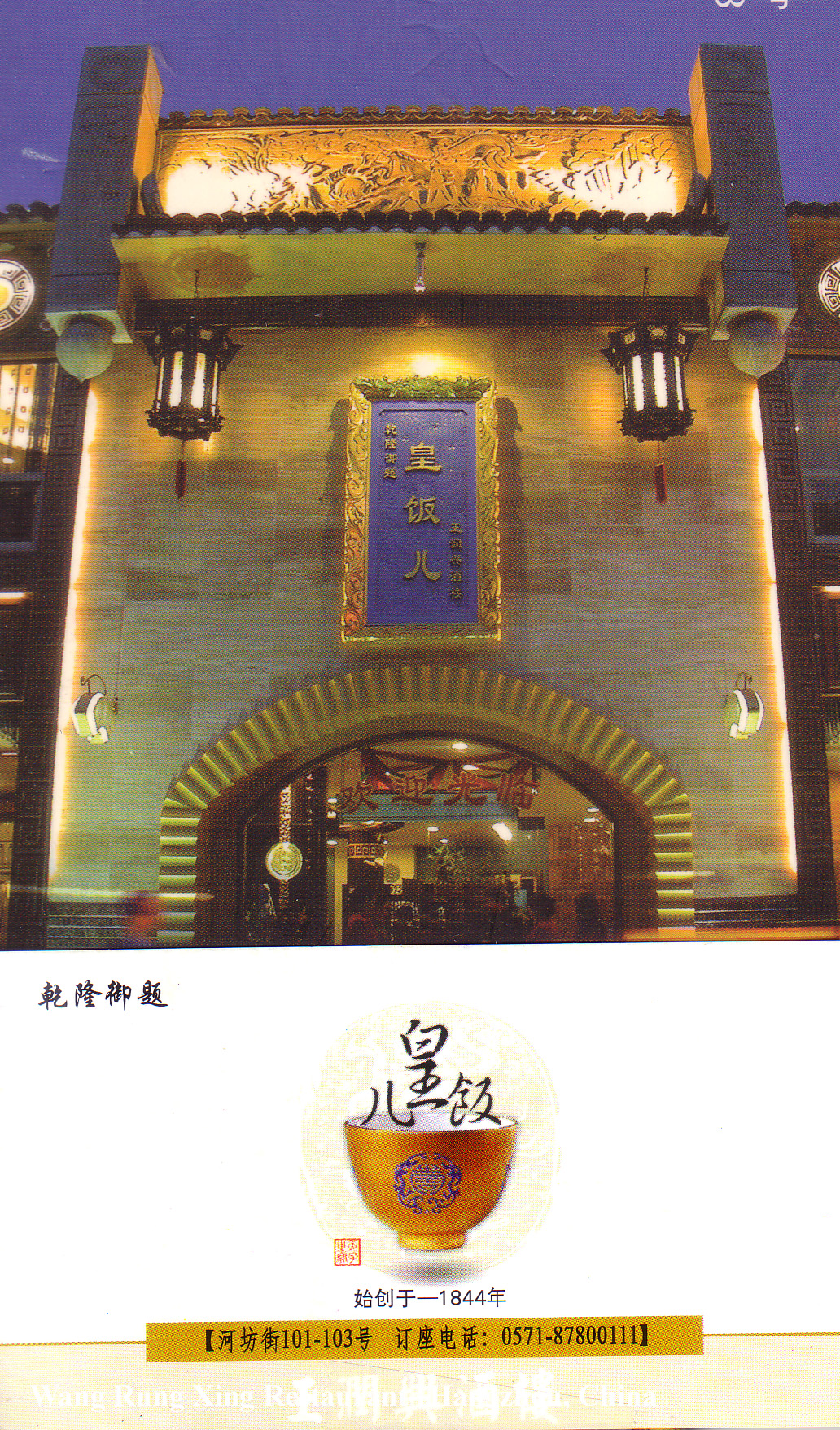
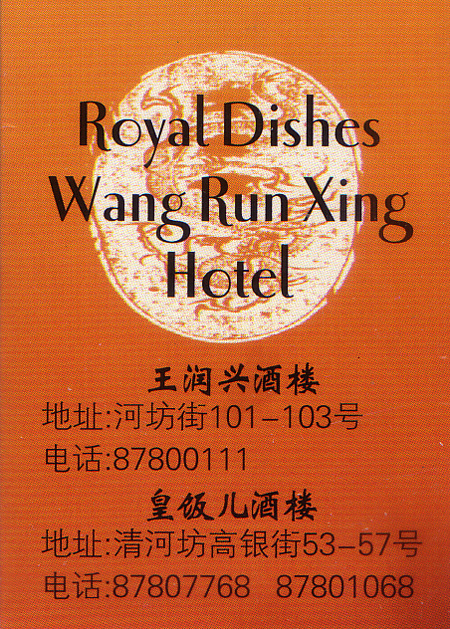 WANG RUN XING HOTEL at 101-103 He Fang Street in Hangzhou; their phone: 0571 8780-0111 served royal dishes, and it intrigues. Our graduate student guides tell us it is better than any of the places we suggest. As they are food history experts and now know our taste buds, we go there for a very big lunch. We are impressed with their choice, the menu and its 'royal dish' offerings sound swell. When the first one arrives, Rice Noodles in Hot Sauce, we know we are in for a great meal. This cold piquant dish sets the tone of the meal, totally upbeat.
WANG RUN XING HOTEL at 101-103 He Fang Street in Hangzhou; their phone: 0571 8780-0111 served royal dishes, and it intrigues. Our graduate student guides tell us it is better than any of the places we suggest. As they are food history experts and now know our taste buds, we go there for a very big lunch. We are impressed with their choice, the menu and its 'royal dish' offerings sound swell. When the first one arrives, Rice Noodles in Hot Sauce, we know we are in for a great meal. This cold piquant dish sets the tone of the meal, totally upbeat.
Three-item Preserved Sweet and Sour arrives next and we wonder what they ordered with this unusual name. Entranced, it is a modern take on an old chilled summer soup of orange juice, dates, and bamboo shoots. It is bright, thick, and refreshing, and we down it quickly.
Dung Po Pork comes next. This sumptuous dish is soft and succulent, cooked for hours, and Oh-so-good! Watershield Soup follows. These soft local vegetable delicacies, freshly removed from the lake, swim with baby shrimp, slivers of ham, and tiny fried egg slices. Together the texture and taste compliment the slippery water shield.
Jelly Fish with Cucumbers, another cold dish comes next. It is so thinly sliced, it makes us wonder who the knife genius is and how many years of practice was needed for such fine slivering. The probable dozens needed show talent as it looks like green hair tossed with decor hiding its culinary coiffure.
Shanghai Cabbage comes loaded with slices of fresh ginger, fresh bamboo shoots, minimal sauce, and maximal taste. A dish of duck tongues follows; they are bone-free with several different fungi rolled and wrapped in lotus leaf. More tasty than words can describe, it is messy to eat with chopsticks, so our fingers get some exercise.
A gift of the house, Fried Bean Curd is set down and we wonder why. It looks boring, bland, and better not tried. That no gratitude for a gift, we try it to learn it is crispy on the outside and tender within, bland at first bite, beautifully seasoned thereafter. The kitchen sent out a winner that did delight their Chinese and western guests. The last dish ordered, Vinegar Shrimp, is in the style of West Lake Fish and teases a tradition. We love it and the artistically carved fruits that come with compliments of the house.
This restaurant has a sister eatery whose kitchen cooks almost identically, we are told. Dishes at both are grounded in royalty as they were served to Emperor Qianlong who ate here during his reign. We leave in the rain after being showered on with such good food.
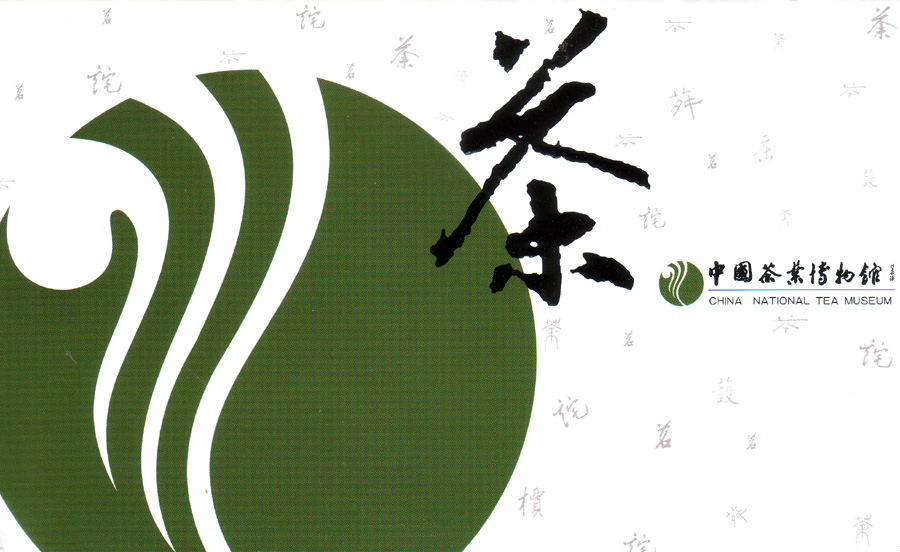
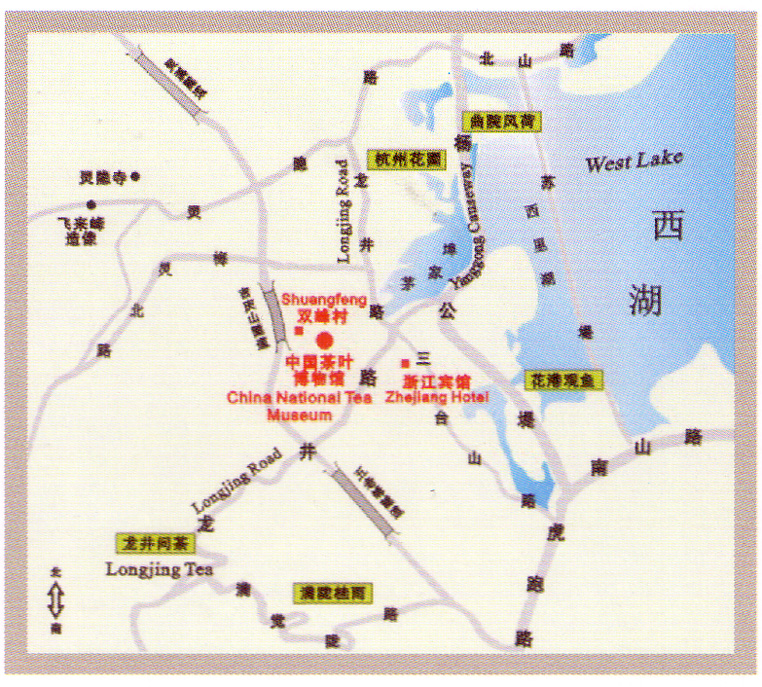 CHINA NATIONAL TEA MUSEUM at 88 Longjing Road in Hangzhou 310013; their phone: 571 87964221 was founded in 1987 by Wu Juenong and twenty-seven other tea experts. It is a local bus ride from downtown. Opened in 1991, tea and tea culture take center stage here where they collect, showcase, study, and share information about China's national beverage.
CHINA NATIONAL TEA MUSEUM at 88 Longjing Road in Hangzhou 310013; their phone: 571 87964221 was founded in 1987 by Wu Juenong and twenty-seven other tea experts. It is a local bus ride from downtown. Opened in 1991, tea and tea culture take center stage here where they collect, showcase, study, and share information about China's national beverage.
Six huge rooms on two floors bring tea history to life. They explain types of tea and places tea grows, bi-lingually. Here one sees tea utensils and enjoys dioramas of the tea customs of the Han and many ethnic minority peoples of China. Situated in the Double Peaks area, the museum is for individual visitors and conference attendees. It has a two hundred forty seat auditorium, multiple translation capabilities, and many tea-tasting rooms. We love the life-size exhibitions about seeing, savoring, and sipping tea.
Inside, one can try any of six tea types be they white, yellow, green, oolong, also known as qing cha, black, and pu-er. These variations come from one plant, Camellia sinensis. An appointment to use its library of thousands of articles, books, and other tea-related materials, is possible; none is required to purchase volumes in its book store. Outside, there are tea gardens to tour. Inside are teas to taste, hundreds of kinds to purchase, a plethora of tea utensils also available for purchase. This museum has two restaurants on the premises. Called Qiwen and Qingten, they serve dishes made with and for tea.
The dioramas and other exhibits show how tea became famous during the Tang Dynasty, and Wang Wen's writing in the Ming Dynasty about cooking with tea. One notes Emperor Song Hui Zong's article about tea, Lu Yu and his classic tea tome, and full-size tea-twisting machines as the one found in Anhwei Province pictured on this page. We note that seventy percent of the world's tea trade is for green tea, and learn white tea comes mostly from the Fujian Province. Ancients said 'water is the mother of tea, and that Lu Yu had twenty-eight kinds of tea sets. He and others spoke about twenty functions of tea including its benefit to eyesight, that it produces saliva, detoxifies ingested toxins, and so much more. There is much more to learn about tea. Check our index listings on our website for earlier items written about this wonderful beverage.
We once read about 'phoenix nodding' and did not understand what it meant. Now we know it is a process of putting tea leaves in a pot and pouring only a small amount of water, repeating this three times to get a perfect cup of tea. Make yourself one now, and learn about fine tea from this magazine and the museum's website: www.teamuseum.cn
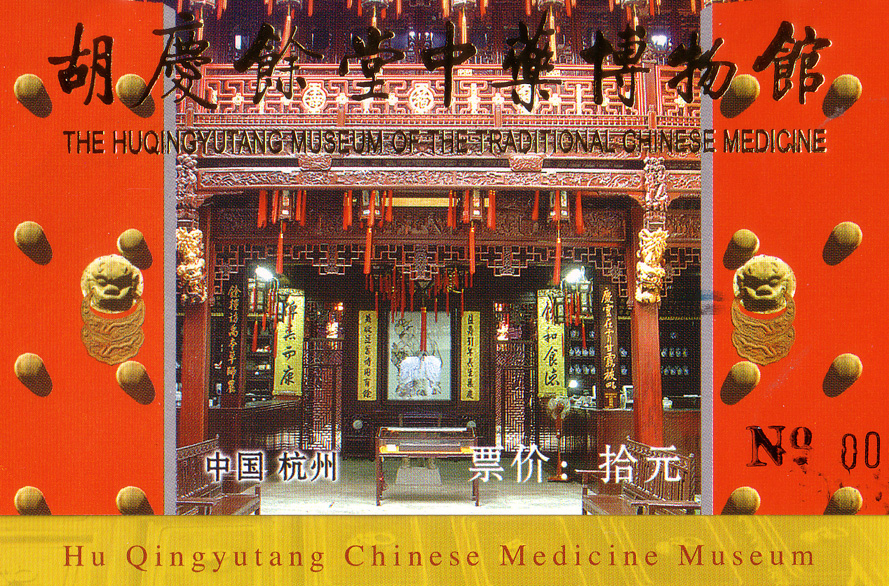 HU QINGYUTANG CHINESE MEDICINE MUSEUM at 95 Dajing Xiang in Hangzhou; their phone 0571 8702-5707 was once an ancient pharmacy. Now China's first medicine-themed museum, it opened in 1999 and honors Hu Xueyan, who in 1874 ran a successful pharmacy in one of the buildings on the site. Some time before he died, he called attention to the importance of Chinese medicine instructing his clerks to parade a live deer, kill it, and show the public that Chinese medicines are free from deception. Deer pills, prepared by the museum's namesake, is still a popular prescription.
HU QINGYUTANG CHINESE MEDICINE MUSEUM at 95 Dajing Xiang in Hangzhou; their phone 0571 8702-5707 was once an ancient pharmacy. Now China's first medicine-themed museum, it opened in 1999 and honors Hu Xueyan, who in 1874 ran a successful pharmacy in one of the buildings on the site. Some time before he died, he called attention to the importance of Chinese medicine instructing his clerks to parade a live deer, kill it, and show the public that Chinese medicines are free from deception. Deer pills, prepared by the museum's namesake, is still a popular prescription.
The Chinese consider Sun Simiao (581 - 682 CE) the 'medicine king.' This pharmacologist of the Tang Dynasty wrote thirty volumes, called Precious Vital Prescriptions about Chinese herbal foods used to treat various medical issues they call 'conditions.'
This museum shows Chinese medicine, Tibetan medicine, Mongolian medicine, Zhuang medicine, Thai medicine, Uygur medicine, and all Han medicinal beliefs and techniques. To all of them, food is medicine and medicine is food. Beliefs here include herbal, acupuncture, moxibustion, and other Asian medicinal practices.
Check out the museums, pottery, dioramas, and other items, past and present. One of them, Tongjun's Records of Gathering Medicines, can be seen. Learn about this elderly gent, an important originator of Chinese medicine. Learn from other important books the many editions of Chinese Materia Medica were revised and expanded though changed minimally. Also learn that China's medicinal food culture began with Shen Nong.
There are exhibits of Li Shizhen (1518 - 1593 CE), the author of the pulse theory who came from Quizhou in Hebei Province. He wrote fifty-three volumes with ten thousand prescriptions and one thousand pictures of medicines. He discusses seventeen methods of concocting, 'pruning,' a system like grinding, water processing, fire processing, and other methods of making them. Zhao Xuemin (1719 - 1805 CE), another contributor to Chinese medicine, wrote twelve books about medicines. All of them are about China's long-held medicinal practices.
The ancient Chinese cooked many herbal mixtures for two or more hours; they called them decoctions. They also used powders, pills, and wines as well as ointments and pastes, topical application methods, and combinations of them all. In modern times, compressed powders make tablets, and powders and liquids are used in capsules, and as injections. Many can be seen here and all are sold in its ancient-looking on-site pharmacy.
The most expensive medications are ginseng, deer antlers, sometimes called deer ears or pilose, tremellia, and bird's nests. These and items of lesser cost are available to those with prescriptions or those who speak to a doctor at their pharmacy.

Copyright © 1994-2025 by ISACC, all rights reserved
Address
3 Jefferson Ferry Drive
S. Setauket NY 11720